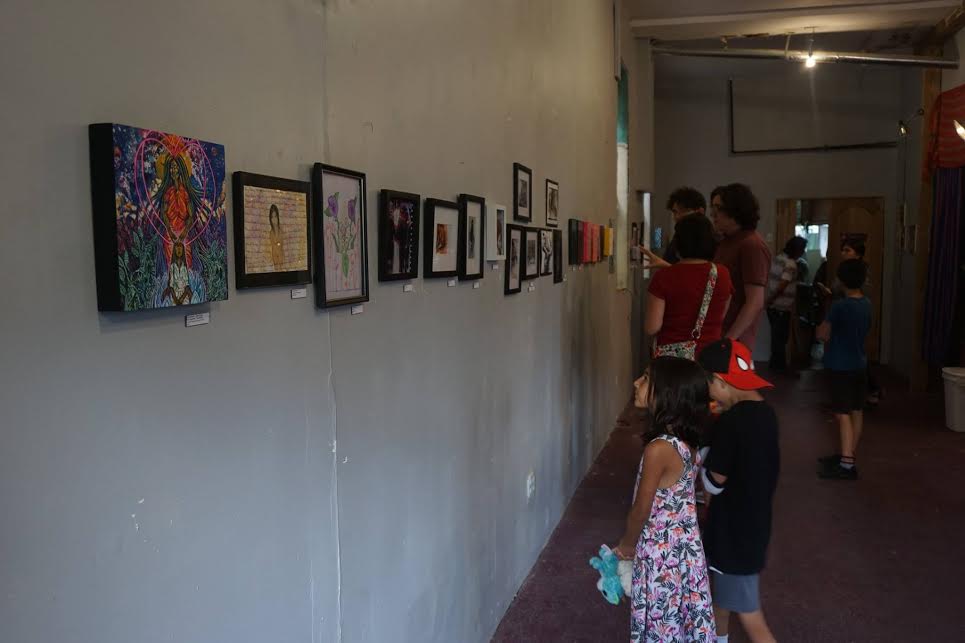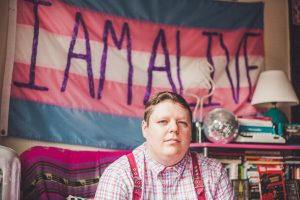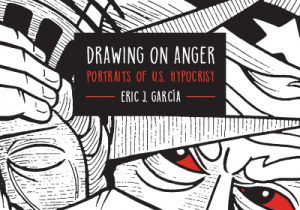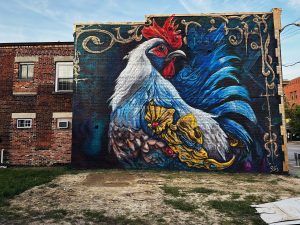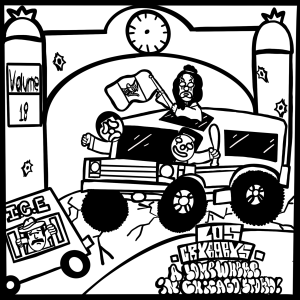The art collective Las Artelitas recently organized an exhibition called Mujer Luchadora/Warrior Woman at their space in Little Village and as part of its mission, they ran a school supply drive. I recently had the opportunity to speak to Amara Betty Martin about the show, the drive, and this amazing women’s collective with a sense of community at its heart. The work of Las Artelitas is an essential addition to the Sixty archive, especially at a time when we are beginning to have larger conversations about art washing and the ways that art spaces can contribute to gentrification or actively be used by developers who are trying to displace residents. In contrast to the typical practice of other types of art spaces that operate in isolation, seemingly uninterested in (or afraid of?) engaging with a neighborhood’s residents or businesses, while privileging the (usually male) individual artist, Las Artelitas finds their strength in the community they have built with one another and the community whose needs they don’t lose sight of. Las Artelitas members include: Adí Patron, Erica Sanchez, Rosa Rodriguez, Sara Cortes, Alyssa Stone, and Amara Betty Martin.
On Aug. 22nd, Las Artelitas will be collecting and distributing school supplies from 5:30 to 7:30 at the Jardincito on 23rd and Whipple.
Jennifer Patiño Cervantes: Can you tell me about the Mujer Luchadora/Warrior Woman show?
Amara Betty Martin: I can’t remember the exact number but we have over 20 artists, male and female. We’re talking about women’s issues, we’re talking about women’s role in the struggle, women’s role in the family, and how women have affected people’s lives. And we’re having a school supply drive that we’re going to distribute those supplies to students in the Little Village area.
JPC: Who in Little Village are you going to give them to?
ABM: We’re actually going to give them to the youth. Some of the girls volunteer at a garden, I believe it’s Whipple and 23rd. It’s called El Jardincito. We do painting there, so we’re just going to kind of flyer the area, and reach out to the young people that we worked with this summer.
JPC: So you said it’s going to touch on women’s issues. How did you go about selecting the artists for the show?
ABM: This time we had an open call for artists. We usually kind of call on people that we know from the community or different artists, but we actually did an open call this time. We have a lot of first-time artists, we have a lot of really young artists, as well.
JPC: Are you going to be showing any work at the show this time, or are you just helping to organize?
ABM: I am showing work, and I’m going to be DJing as well.
JPC: I was going to ask you about that! Specifically about your work—how do you feel that your work as a DJ intersects with your visual art, if you feel it intersects at all?
ABM: There definitely is an intersection, but I don’t view them as separate things. I’m kind of influenced by everyday life and the things I experience in my life, and music and sound is a really big part of that. It’s a natural part of life for me.
JPC: What kind of vibe do you try to create at shows with your DJing?
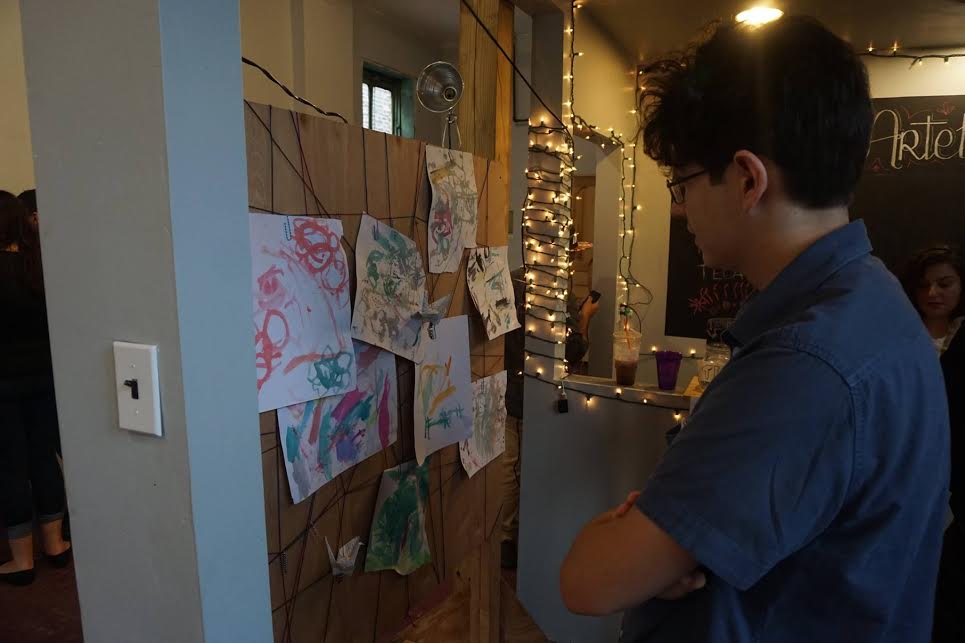
ABM: It really depends on the kind of event that I’m at. I do play a lot of Latino-focused events, so I try to touch on a lot of Latino music, but especially music that has African roots in it.
JPC: Do you know what you’re showing yet? How does your process work when you’re picking art for your shows that you are going to be showing yourself?
ABM: Well, I made new pieces for this show. Most of my work has been focused on women for the last few months since I got back from Mexico, but I’ve been putting poetry into my art. I definitely interwove text talking about women and women’s roles, and kind of pulling memories from elder women, which what I’ve really been thinking about: elders and the information that they hold, and sometimes that they take with them when they pass.
JPC: Is this a new focus for your work? Is it something that you’ve been focusing on since you got back from Mexico?
ABM: It is a new focus. Before it was more generalized, or maybe looking at youth a lot. I’ve just been interested in looking at women more lately, and particularly older women. Probably just the last two and a half months or so.
JPC: Who in the group came up with the idea for the show?
ABM: We had an idea for talking about women—it was kind of a group effort. We were going to have a group show and we knew we wanted to talk about something that relates to us all. We’ve been talking a lot about the idea of being a women’s collective, and examining the idea of being a woman and being a woman in the struggle more. So it was a collective effort.
JPC: Can you talk a little bit more about the specific warrior woman aspect, the luchadora, in the context of the social justice aspect of what you guys do?
ABM: I think we’ve been thinking a lot about the idea of women’s roles, and just thinking that whatever role a woman is in, whether that’s a mother, or a healer, or a teacher, in some kind of way she is a part of the struggle and in that way, she herself is a warrior. Whether that’s a passive role, in caring for children or whatever that is, or being on the front lines, every woman, no matter what they’re doing, has to accept that role. It’s a natural role for herself.
JPC: How did the school supply drive come about?
ABM: We had thought about it earlier in the year. A lot of us work in education, and one of the biggest problems is that kids come to school without pencils, without paper, and because we work with teachers we realize the toll that takes on the teacher, who then has to purchase the supplies out of their own money. So we kind of thought it was a way to send kids to school prepared. I had to go to school a few times with no supplies. And you get kind of brushed off like just a poor kid. So we just wanted to give something back and we thought that would be a really good way to do that.
JPC: That’s great! If there are people who would like to contribute to the school supply drive but they can’t make it to the show, is there any way they can do that?
ABM: We can take mail-in donations, I actually didn’t even think about that. We don’t have any kind of online account, but we can take mail-in donations to our gallery at 2320 S Kedzie.
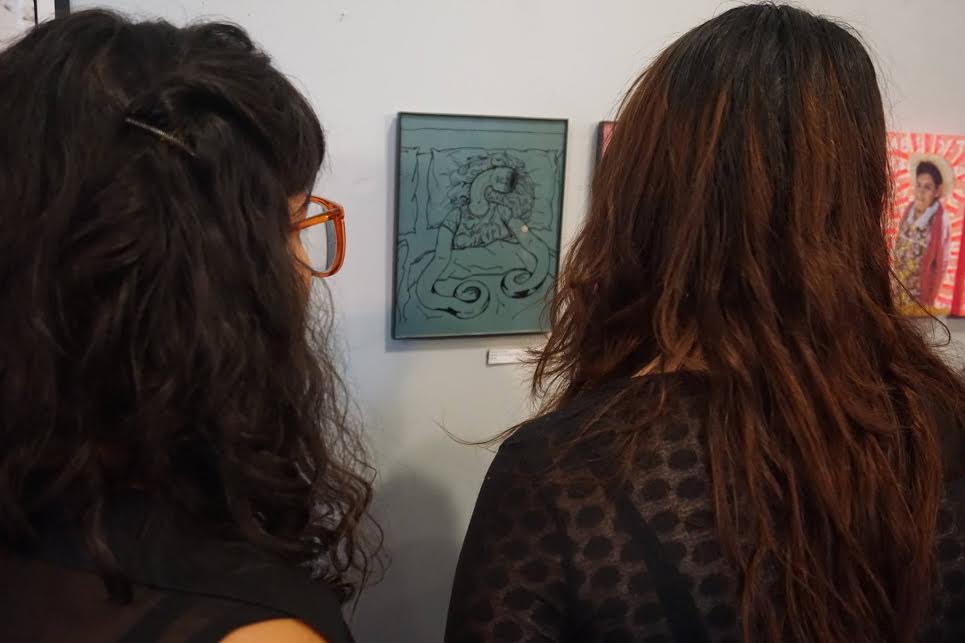
JPC: Can you tell me a little bit more about your collective and how it came about?
ABM: Actually, this show is going to be our second anniversary of the collective. I’ve been organizing for a while, and one of the other girls, Sara, I know her from organizing. I met her like five years ago. I had just moved to Little Village at that point, and I didn’t have any spaces to work at in the neighborhood. My girl Sara introduced me to Erica. Erica’s dad owns the building where our space is. She actually rents several businesses out of there, it was a video store, it was a video game store, and then it was a furniture store, and right now, it’s kind of like a warehouse. So she invited me, and even without seeing it, I kind of said “yes” and ever since then we’ve been organizing. But we kind of came together because we were all going through a transitional period in our lives, and then we all found ourselves without an organizing space. All of us grew up going to underground events, or organizing in underground spaces, so we were kind of feeling like we didn’t have anything anymore. We were stuck in bars, all these unsafe spaces. So we really wanted to create that for ourselves, and for our friends and community.
JPC: How has the community reacted to your space and your collective being there?
ABM: It’s actually been really positive. Little Village doesn’t have lots of year-round cultural events. We have really big things like Villapalooza, Villarte, things that come around once a year. And so people, especially young people, people even younger than me and the girls are, have responded really positively to the space. It’s a safe space for them, it’s a space for people of color to gather. All of the stories that we’re sharing and the shows that we’re having are speaking specifically to their issues. We don’t have any show that isn’t intentional in that way.
JPC: I just have to say, I really love the name “Las Artelitas.”
ABM: Thank you! We were voting on names, and Rosa actually came up with that because, her idea was that even though we are artists and we aren’t out on the front lines fighting the revolution that way, again, it comes back to the idea of the show—we still have a role in the struggle. Our role is art.
JPC: I think it’s really interesting that you are including a school supply drive as a part of it too. It’s not very often that you see art spaces really thinking about the needs of the community in such a direct and simple way that people can help.
ABM: It is really simple. We’re not asking for money, we aren’t raising money to do anything out of the ordinary. Sometimes it’s those ordinary things that people look over.
JPC: Thinking about the next generation, maybe I’m just editorializing now, but it seems really cool that you’ve been thinking about the previous generation for your art for your show, and you’re also thinking about the next generation with the school supply drive.
ABM: Yeah, and I think the idea of family is really important to us because some of us, we may not have nuclear families, but that last event that you were at, that kind of ambiance it feels like family, and you’re playing family games, and you know. We don’t have the most grandest plans for revolution and changing everything, we just know about building relationships and realizing the small ways that we can help each other. That’s our contribution, and that seems like enough for us for now.
All images of Mujer Luchadora/Warrior Woman courtesy of Marcela Gómez.
Jennifer Patiño Cervantes was born on the Southwest Side of Chicago and her family is from Mexico. She is a freelance writer, poet, essayist, and Director of Development for Sixty Inches From Center. She graduated from Columbia College with a degree in Art History and double minors in Poetry and Latino/Hispanic Studies. She is a lover of Chicago’s Visual Arts and Literary communities and lives to explore the links between them.
